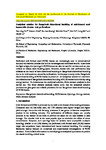Analytical solution for flange/web distortional buckling of cold-formed steel beams with circular web perforations
| dc.contributor.author | Voudouris, Vlasios | |
| dc.contributor.author | Kim, Boksun | |
| dc.contributor.author | Huang, X-H | |
| dc.contributor.author | Yuan, W-B | |
| dc.contributor.author | Ye, R | |
| dc.contributor.author | Wu, L | |
| dc.contributor.author | Le, J-J | |
| dc.date.accessioned | 2021-05-27T16:01:37Z | |
| dc.date.available | 2021-05-27T16:01:37Z | |
| dc.date.issued | 2021-03-26 | |
| dc.identifier.issn | 1075-9417 | |
| dc.identifier.issn | 1537-6532 | |
| dc.identifier.uri | http://hdl.handle.net/10026.1/17206 | |
| dc.description.abstract |
Perforated cold-formed steel (PCFS) beams are increasingly used in constructional industry and become popular due to their advantages and economic benefit. Apart from the light weight, the openings in PCFS beams can also be used for services such as pipe utilities to release more building space. However, beams with web perforations may collapse as the result of web-distortional buckling or flange/web distortional buckling due to the web weakness caused by perforations. In this paper a study on the flange/web distortional buckling of PCFS beams is presented. An analytical solution to determine the critical stress of flange/web distortional buckling of PCFS beams is derived by using energy method. To demonstrate the analytical solution, finite element analysis is also carried out. The finite element analysis results show that the analytical solution provided can give good and reliable prediction for the flange/web distortional buckling of PCFS beams. | |
| dc.format.extent | 1-11 | |
| dc.language | en | |
| dc.language.iso | en | |
| dc.publisher | Taylor & Francis | |
| dc.subject | Energy method | |
| dc.subject | finite element analysis | |
| dc.subject | flange | |
| dc.subject | web distortional buckling | |
| dc.subject | openings | |
| dc.subject | PCFS beams | |
| dc.title | Analytical solution for flange/web distortional buckling of cold-formed steel beams with circular web perforations | |
| dc.type | journal-article | |
| dc.type | Journal Article | |
| plymouth.author-url | https://www.webofscience.com/api/gateway?GWVersion=2&SrcApp=PARTNER_APP&SrcAuth=LinksAMR&KeyUT=WOS:000634156500001&DestLinkType=FullRecord&DestApp=ALL_WOS&UsrCustomerID=11bb513d99f797142bcfeffcc58ea008 | |
| plymouth.issue | 24 | |
| plymouth.volume | 29 | |
| plymouth.publication-status | Published | |
| plymouth.journal | Mechanics of Advanced Materials and Structures | |
| dc.identifier.doi | 10.1080/15376494.2021.1902594 | |
| plymouth.organisational-group | /Plymouth | |
| plymouth.organisational-group | /Plymouth/Faculty of Science and Engineering | |
| plymouth.organisational-group | /Plymouth/Faculty of Science and Engineering/School of Engineering, Computing and Mathematics | |
| plymouth.organisational-group | /Plymouth/REF 2021 Researchers by UoA | |
| plymouth.organisational-group | /Plymouth/REF 2021 Researchers by UoA/UoA12 Engineering | |
| plymouth.organisational-group | /Plymouth/Users by role | |
| plymouth.organisational-group | /Plymouth/Users by role/Academics | |
| dcterms.dateAccepted | 2021-03-09 | |
| dc.rights.embargodate | 2022-3-26 | |
| dc.identifier.eissn | 1537-6532 | |
| dc.rights.embargoperiod | Not known | |
| rioxxterms.versionofrecord | 10.1080/15376494.2021.1902594 | |
| rioxxterms.licenseref.uri | http://www.rioxx.net/licenses/all-rights-reserved | |
| rioxxterms.licenseref.startdate | 2021-03-26 | |
| rioxxterms.type | Journal Article/Review |


